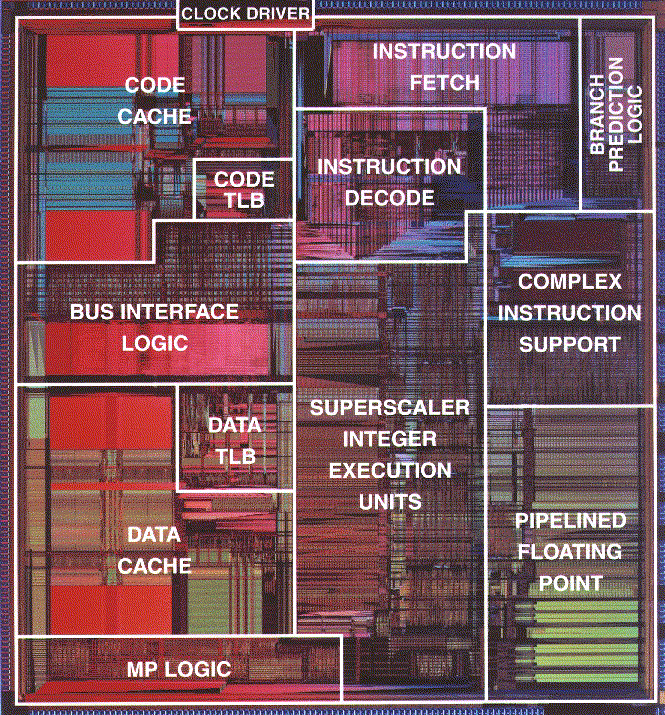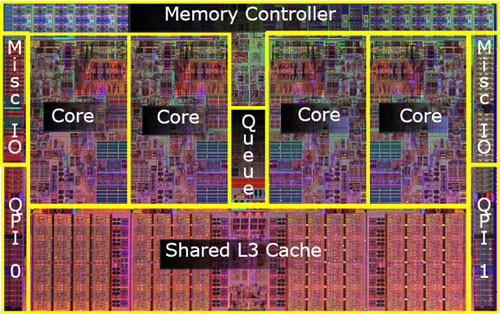CSC231 Class Page 2015
--D. Thiebaut (talk) 11:28, 26 August 2015 (EDT)
| Week 1 Sept 7 |
Topics: Introduction, Python, Idle, Piazza, Moodle submission Lab/Hw Reading - Wednesday
- Syllabus
- Class accounts
- The main players for this semester:
- PC
- Processor
- Memory
- Disk
- First program in assembly: recognize the different elements:
- Structure
- Presentation
- Documentation
- Skeleton program
- Hello World! on Linux (and its Mac version)
- Reading
- Chapter 1 in the Art of Assembly.
- Also Chapter 3, Sections 0 to 3.1.2.
- Sections 1.3.1, 1.3.2, 1.3.3, 1.3.4, and 1.3.5 in Carter's PC Assembly Language. Note, Carter uses 1A92h to represent a hexadecimal number. I prefer 0x1A92.
- Wednesday
| Week 2 Sept. 14 |
Topics: Processor and Memory, working with the shell, and emacs. Lab/Hw Reading - Monday:
- Review PC destruction lab. Main players: Processor, cores, RAM, motherboard, crystal
- How would Richard Tuttle see a computer motherboard? This is some of his artwork.
- First diagram of a computer as seen by an assembly language programmer
- Review Hello World program with this new knowledge
Notice how the main character uses all kinds of software packages to solve his problem. It includes working in a shell, using shell commands, and mixing the results with various programming techniques.
- Wednesday
- Linux System Calls. See Slide 5 of this presentation
- Working in a shell
- The bash shell
- Playing with the shell using 231a-xx accounts
- Useful commands
- ls, cd, pwd, mkdir, rm, rmdir, cp
- history, !, !!, alias, w, ps, who am i
- grep, wc, head, tail
- Redirection
- Pipes
- Emacs
- quick overview (see this page)
- set of commands
- Lab
- Homework
| Week 3 Sept. 21 |
Topics: Number Systems, the MOV instruction Lab/Hw Reading - Monday:
- Let's talk about the crystal
- Relationship with instructions
- Power-law for increase in processor speed
- Ray Kurzweil on Power Laws (go to marker 3:30 min in video)
- Playing a game of numbers
- Hexadecimal system:
for i in range( 256 ): print( i, format( i, '02X' ) )
- Assembly:
- Review nasm, ld
- Understanding how data fits in memory: printing strings defined by db
- Size of a program: data + code
size helloWorld2 text data bss dec hex filename 34 14 0 48 30 helloWorld2
- Listing of the assembly and its code:
nasm -f elf -l helloWorld2.lst helloWorld2.asm ls ... helloWorld2.lst ...
- Wednesday
- Quick check of number conversion skills
- Observe output of nasm -l (helloWorld2.lst)
- Another way to look at the executable file with hexdump
hexdump -v -C helloWorld2 00000000 7f 45 4c 46 01 01 01 00 ... ... 000002b0 74 61 00 5f 65 6e 64 00 |ta._end.| 000002b8
- Observe the output of hexdump command
- Finish the reading assigned for Week 1.
- The mov instruction
| Week 4 Sept. 28 |
Topics: The Mov instruction. Arithmetic instructions. Addressing Modes. Lab/Hw Reading - Monday:
- Wednesday
- A script to automatically assemble and link assembly programs
- Review: MOV instruction: direct and immediate modes of addressing data
- Examples: copying a string to another string
- Exercises with the MOV instruction
- The ADD instruction
- Overly-simplified encryption of a string
- Chapter 3, Section 1 in The Art of Assembly, to Section 3.2.2.
| Week 5 Oct 5 |
Topics: Lab/Hw Reading - Monday:
- Arithmetic instructions: ADD, SUB, INC, DEC. Skip MUL and DIV for right now.
- A quick introduction to calling functions: CALL and RET
- Printing decimal numbers in assembly
- A first look at what is behind code like this:
int a; int b; int c; a = 3; b = 5; c = a + b;
- Example of what the GNU cc compiler would have generated
- Exercise 1: "Compile" the following statements to assembly:
int a; int b; int c; int d; a = 3; b = 5; c = a*2 + b; d = (a + b + 10 + 2*c ) * 2 - 20;
- Exercise 2: translate the following code in assembly. If you need to refresh your memory on Java types, check this document out:
int a = 3, b = 5, c; short d = 10, e = 0xff, f = 0; c = ( a * 2 + b ) * 3; f = d + (e-1); c = a * 2* d;
- Wednesday
- Mountain Day?
- Big Endian vs. Little Endian hardware. Why does it matter?
- page with some little-endian and big-endian architectures.
- Section 4.1 of Paul Carter's ebook presents indirect addressing. Read this first. Read also Section 5.1.3 about more sophisticated indirect addressing modes.
- The CALL and RET instructions
| Week 6 Oct. 12 |
Topics: call/ret, looping, mul/div Lab/Hw Reading - Monday: Fall Break
- Wednesday
- Back to call and ret instructions: defining and using functions.
- Exercise 1: Create a function that adds two int variables together
- Exercise 2: Add a function that prints the two variables and their sum
- mul and div: multi-register instructions. EDX:EAX used as default registers.
- Exercise 3: Write a Teller-Machine program
- LOOP: Read Section 2.2.3 (Page 41) in Paul Carter's book.
- MUL: Read Section 2.1.3 (Page 33) in Paul Carter's book. Do not worry about the mention of 2's complement. Just concentrate on the registers that are used.
- CALL/RET: Section 4.4 (Page 65) in Paul Carter's book.
| Week 7 Oct 19 |
Topics: Lab/Hw Reading - Monday:
- Back to mul and div: Java and Python multiply ints differently
- Exercise 1: Write a Teller-Machine program
- The loop instruction: ECX is the counter
- Exercise 2: Compute the sum of all ints between 1 and n. (There are many possible answers)
- Exercise 4: What is the largest amount of looping we can do with the loop instructions?
- Exercise 5: How long does it take a loop to accumulate the sum of all the ints between 1 and 1,000,000? Any particular issues one should be worried about?
- Program 3: Teller machine program.
- Program 4: Teller machine with function.
- Wednesday
- Comparing execution speed of Java vs C++, vs Nasm, vs Python.
- Measuring user time with the Linux time command:
- The user time is how long your program was running on the processor. The sys time is how long your program was waiting for the OS to perform tasks for it. In general, (user time + sys time) is a good approximation of the time your program needs to run to completion. The real time contains the time that other processes took out of the CPU while your program was running.
- How many processes are running at the same time? ps and top commands.
- Addressing modes: the response of processor designers to the complexity of high-level languages.
- Slides on addressing modes
- inherent
- register
- immediate
- direct
- indirect/based/indexed
- indirect with displacement
- base-indexed
- base-indexed with displacement
- Exercises on Loops
- Exercises on Loops and Addressing Modes (Problems 2 to 6)
- No homework this week. Prepare for the midterm!
- Section 4.1 of Paul Carter's ebook presents indirect addressing. Read this first. Read also Section 5.1.3 about more sophisticated indirect addressing modes.
| Week 8 Oct. 26 |
Topics: Lab/Hw Reading - Monday: Midterm Exam: in class, on paper, closed everything.
- Wednesday
- Logic Instructions: OR, AND, XOR, NOT: they work in binary!
- Using logic instruction to mask various bit sections.
- Exercise:
- Clear the upper 16 bits of eax
- Set the upper 4 bits of al to 0
- Set the lower 4 bits of al to 1
- Logic Gates: AND, OR, and NOT. That's what a computer is made of!
- Taking a look at the mother board of an Apple computer.
- The AND, OR, and Inverter gates in one pdf
- Schematics from NASA, and a specific sheet showing logic gates.
- Schematics of 2-bit Adder
- AND, OR, (XOR), NOT (on [Wikipedia])
- A 2-bit adder with logic gates.
- Reading
- Logical Operations on Bits
- Section 3.2 on Bit operations (AND, OR, NOT, XOR) in Carter's eBook. Look at the section that follows on bit manipulation in C. The same operations are also supported in Java.
| Week 9 Nov. 2 |
Topics: Lab/Hw Reading - Monday:
- Wednesday
- Lab
- Homework
| Week 10 Nov 9 |
Topics: Lab/Hw Reading - Monday:
- Wednesday
- Lab
- Homework
| Week 11 Nov 16 |
Topics: Lab/Hw Reading - Monday:
- Wednesday
- Lab
- Homework
| Week 12 Nov 23 |
Topics: Lab/Hw Reading - Monday:
- Wednesday: Thankgiving Break
- Lab
- Homework
| Week 13 Nov 30 |
Topics: Lab/Hw Reading - Monday:
- Wednesday
- Lab
- Homework
| Week 14 Dec 7 |
Topics: Lab/Hw Reading - Monday:
- Wednesday
- Lab
- Homework
| Week 15 Dec 14 |
Topics: Lab/Hw Reading - Monday: Last Class
- Final Exam
Links and Resources
- Notes on Assembling 32-bit Code on 64-bit Machines
- Hello Word in assembly running on Mac OS and on Linux




